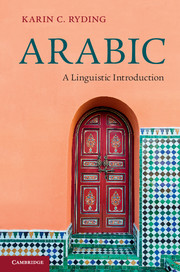Book contents
- Frontmatter
- Contents
- List of figures
- Preface
- Acknowledgments
- Abbreviations and symbols used in this book
- 1 Arabic linguistics: overview and history
- 2 Arabic phonology
- 3 Arabic phonotactics and morphophonology
- 4 Arabic syllable structure and stress
- 5 Introduction to Arabic morphology
- 6 Derivational morphology: the root/pattern system
- 7 Non-root/pattern morphology and the Arabic lexicon
- 8 Arabic inflectional morphology
- 9 Syntactic analysis and Arabic
- 10 Arabic syntax I: phrase structure
- 11 Arabic syntax II: clause structure
- Appendix A Fields of linguistics and Arabic
- Appendix B Arabic transcription/transliteration/romanization
- Appendix C Arabic nominal declensions
- Glossary of technical linguistic terms
- References
- Index
- References
5 - Introduction to Arabic morphology
Published online by Cambridge University Press: 05 June 2014
- Frontmatter
- Contents
- List of figures
- Preface
- Acknowledgments
- Abbreviations and symbols used in this book
- 1 Arabic linguistics: overview and history
- 2 Arabic phonology
- 3 Arabic phonotactics and morphophonology
- 4 Arabic syllable structure and stress
- 5 Introduction to Arabic morphology
- 6 Derivational morphology: the root/pattern system
- 7 Non-root/pattern morphology and the Arabic lexicon
- 8 Arabic inflectional morphology
- 9 Syntactic analysis and Arabic
- 10 Arabic syntax I: phrase structure
- 11 Arabic syntax II: clause structure
- Appendix A Fields of linguistics and Arabic
- Appendix B Arabic transcription/transliteration/romanization
- Appendix C Arabic nominal declensions
- Glossary of technical linguistic terms
- References
- Index
- References
Summary
Word structure
Ask most anyone, and they will say that words are at the heart of language. Words are definitely at the center of discourse, and single words are the first language elements that infants normally acquire. But seemingly simple questions such as “what is a word?” have been surprisingly difficult to answer. Distinctions can be made according to various criteria. Three general aspects of “word” can be listed: the phonological word or word as a phonological unit; the lexeme, or content word with a dictionary meaning; and the “grammatical word,” the word stem that serves as a base for grammatical/inflectional markers. One definition of ‘word’ is “a unit of expression which has universal intuitive recognition by native-speakers, in both spoken and written language” (Crystal 1997b: 419). However, the concept of “intuitive recognition” is neither empirical nor rigorous. Another definition is “the smallest of the linguistic units which can occur on its own in speech or writing” (Richards and Schmidt 2010: 636). Here again, the concept of “on its own” is open to discussion. As Richards and Schmidt note, “it is difficult to apply this criterion consistently” (2010: 636). Morphology, the study of word structure, examines systematically the nature of words, their forms, their components, their interactions, and – to some extent – their meanings.
What is linguistic morphology?
Morphology in linguistics deals with the structure of words: how they are formed and the identity and character of their component features. Sometimes words consist of solid stems (such as the Arabic noun yad ‘hand’ or the English word book), but more often (especially in Arabic) words are composed of more than one morpheme (such as the English words books, bookshelf, booked; or the Arabic word maktab ‘office’ consisting of the lexical root morpheme { k-t-b} ‘write’ and the grammatical pattern morpheme specifying “place,” { ma __ __ a __ }). A morpheme, then, can be defined as a minimum unit of form endowed with an independent meaning. Another definition is that a morpheme is “a minimal distinctive unit of grammar, and the central concern of morphology” (Crystal 1997b: 248). Morphemes may be free, meaning that they can stand alone as words, or they may be bound, meaning that they exist only as components of words. In Arabic, most words are morphologically complex, that is, they consist of more than one morpheme.
- Type
- Chapter
- Information
- ArabicA Linguistic Introduction, pp. 41 - 54Publisher: Cambridge University PressPrint publication year: 2014
References
- 1
- Cited by



